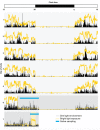Sensitivity of the circadian system to evening bright light in preschool-age children
- PMID: 29504270
- PMCID: PMC5835497
- DOI: 10.14814/phy2.13617
Sensitivity of the circadian system to evening bright light in preschool-age children
Abstract
Although the light-induced melatonin suppression response is well characterized in adults, studies examining the dynamics of this effect in children are scarce. The purpose of this study was to quantify the magnitude of evening light-induced melatonin suppression in preschool-age children. Healthy children (n = 10; 7 females; 4.3 ± 1.1 years) participated in a 7-day protocol. On days 1-5, children followed a strict sleep schedule. On day 6, children entered a dim light environment (<15 lux) for 1-h before providing salivary samples every 20- to 30-min from the afternoon until 50-min after scheduled bedtime. On day 7, subjects remained in dim light conditions until 1-h before bedtime, at which time they were exposed to a bright light stimulus (~1000 lux) for 1-h and then re-entered dim light conditions. Saliva samples were obtained before, during, and after bright light exposure and were time anchored to samples taken the previous evening. We found robust melatonin suppression (87.6 ± 10.0%) in response to the bright light stimulus. Melatonin levels remained attenuated for 50-min after termination of the light stimulus (P < 0.008). Furthermore, melatonin levels did not return to 50% of those observed in the dim light condition 50-min after the light exposure for 7/10 children. Our findings demonstrate a robust light-induced melatonin suppression response in preschool-age children. These findings have implications for understanding the role of evening light exposure in the development of evening settling difficulties and may serve as experimental evidence to support recommendations regarding light exposure and sleep hygiene practices in early childhood.
Keywords: Circadian; light; melatonin suppression; preschool children; sleep.
© 2018 The Authors. Physiological Reports published by Wiley Periodicals, Inc. on behalf of The Physiological Society and the American Physiological Society.
Figures



References
-
- American Academy of Pediatrics . 2011. Media use by children younger than 2 years. Pediatrics 128:1040–1045. - PubMed
-
- Beltramini, A. U. , and Hertzig M. E.. 1983. Sleep and bedtime behavior in preschool‐aged children. Pediatrics 71:153–158. - PubMed
-
- Borjigin, J. , Li X., and Snyder S. H.. 1999. The pineal gland and melatonin: molecular and pharmacologic regulation. Annu. Rev. Pharmacol. Toxicol. 39:53–65. - PubMed

